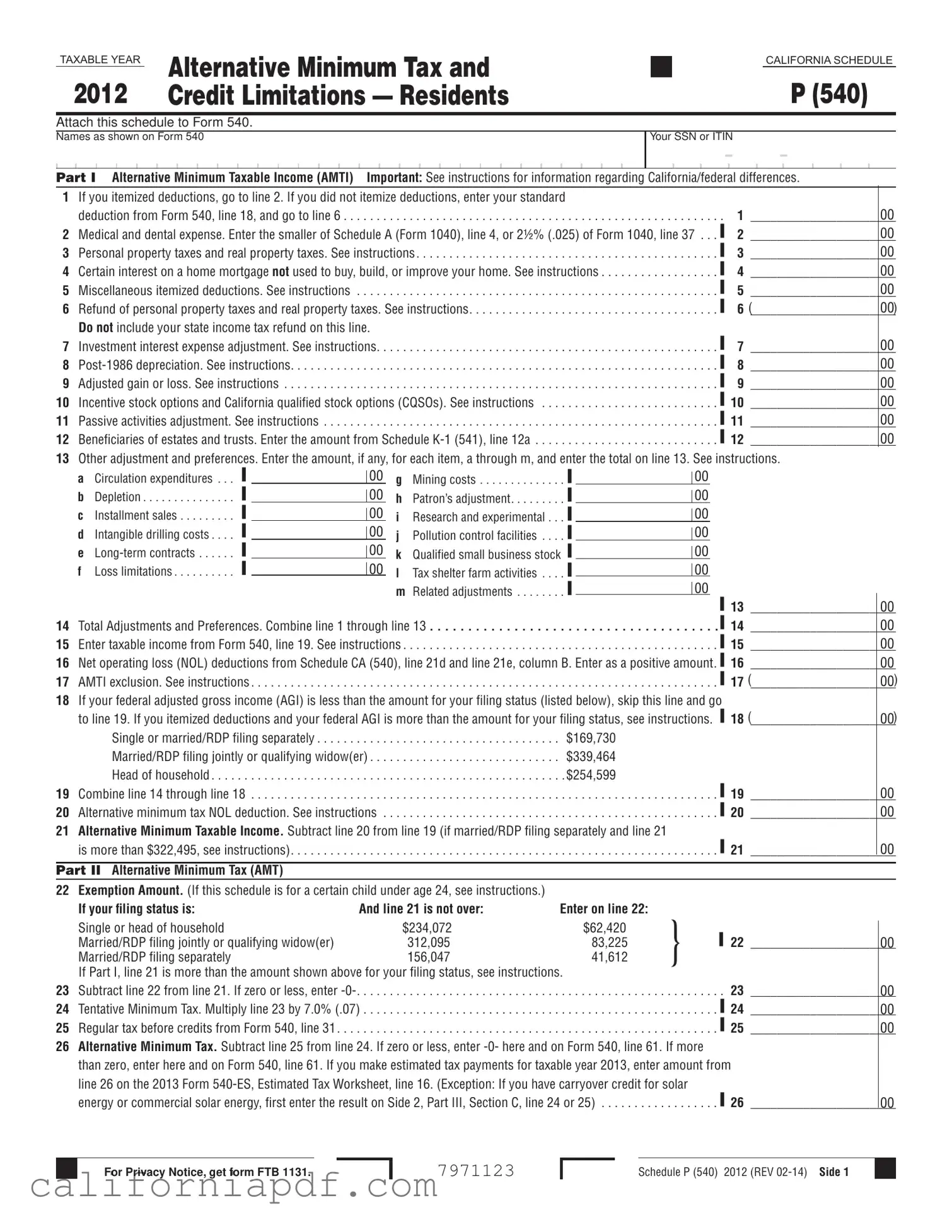PART I Alternative Minimum Taxable Income (AMTI) Important: See instructions for information regarding California/federal differences.
1If you itemized deductions, go to line 2. If you did not itemize deductions, enter your standard
|
deduction from Form 540, line 18, and go to line 6 |
.▌ |
1 |
|
2 |
Medical and dental expense. Enter the smaller of Schedule A (Form 1040), line 4, or 2½% (.025) of Form 1040, line 37 . . . |
2 |
|
3 |
Personal property taxes and real property taxes. See instructions |
▌ |
3 |
|
4 |
Certain interest on a home mortgage not used to buy, build, or improve your home. See instructions |
▌ |
4 |
|
5 |
Miscellaneous itemized deductions. See instructions |
▌ |
5 |
|
6 |
Refund of personal property taxes and real property taxes. See instructions |
▌ |
6 |
( |
|
Do not include your state income tax refund on this line. |
▌ |
|
|
7 |
Investment interest expense adjustment. See instructions |
7 |
|
8 |
Post-1986 depreciation. See instructions |
▌ |
8 |
|
9 |
Adjusted gain or loss. See instructions |
▌ |
9 |
|
10 |
Incentive stock options and California qualified stock options (CQSOs). See instructions |
▌ 10 |
|
11 |
Passive activities adjustment. See instructions |
▌ 11 |
|
12 |
Beneficiaries of estates and trusts. Enter the amount from Schedule K-1 (541), line 12a |
▌ 12 |
|
13Other adjustment and preferences. Enter the amount, if any, for each item, a through m, and enter the total on line 13. See instructions.
a |
Circulation expenditures |
▐ |
|
|
00 |
g |
Mining costs |
▐ |
|
|
00 |
|
|
|
|
|
b |
Depletion |
▐ |
|
|
00 |
h |
Patron’s adjustment |
▐ |
|
|
00 |
|
|
|
|
|
c |
Installment sales |
▐ |
|
|
00 |
i |
Research and experimental |
▐ |
|
|
00 |
|
|
|
|
|
d |
Intangible drilling costs . |
▐ |
|
|
00 |
j |
Pollution control facilities . |
▐ |
|
|
00 |
|
|
|
|
|
e |
Long-term contracts . . . |
▐ |
|
|
00 |
k |
Qualified small business stock ▐ |
|
|
00 |
|
|
|
|
|
f |
Loss limitations |
▐ |
|
|
00 |
l |
Tax shelter farm activities . |
▐ |
|
|
|
|
|
|
|
|
00 |
|
|
|
|
|
|
|
|
|
|
|
|
m Related adjustments |
▐ |
|
▐ 13 |
|
|
|
|
|
|
|
|
00 |
|
|
|
|
|
|
|
|
|
|
|
|
|
|
|
|
|
|
|
14 Total Adjustments and Preferences. Combine line 1 through line 13 |
. . . . . . . . . . . . . . . . |
. . |
. ▌ 14 |
15 Enter taxable income from Form 540, line 19. See instructions . |
. . . . . . . . . . . . . . . . . . . . . . . . . . . . . . . . . . . . . . . . . . . |
|
. . . |
. ▌ 15 |
16Net operating loss (NOL) deductions from Schedule CA (540), line 21d and line 21e, column B. Enter as a positive amount. ▌ 16
17 AMTI exclusion. See instructions . . . . . . . . . . . . . . . . . . . . . . . . . . . . . . . . . . . . . . . . . . . . . . . . . . . . . . . . . . . . . . . . . . . . . . . ▌ 17 (
18If your federal adjusted gross income (AGI) is less than the amount for your filing status (listed below), skip this line and go
to line 19. If you itemized deductions and your federal AGI is more than the amount for your filing status, see instructions. ▌ 18 (
|
Single or married/RDP filing separately |
$169,730 |
|
Married/RDP filing jointly or qualifying widow(er) |
$339,464 |
|
Head of household |
$254,599 |
19 |
Combine line 14 through line 18 |
. . . . . . . . . . . . . . . . . . . . . . . ▌ 19 |
20 |
Alternative minimum tax NOL deduction. See instructions |
. . . . . . . . . . . . . . . . . . . . . . . ▌ 20 |
21Alternative Minimum Taxable Income. Subtract line 20 from line 19 (if married/RDP filing separately and line 21
is more than $322,495, see instructions). . . . . . . . . . . . . . . . . . . . . . . . . . . . . . . . . . . . . . . . . . . . . . . . . . . . . . . . . . . . . . . . .
PART II Alternative Minimum Tax (AMT)
22Exemption Amount. (If this schedule is for a certain child under age 24, see instructions.)
|
If your filing status is: |
And line 21 is not over: |
Enter on line 22: |
|
|
|
Single or head of household |
$234,072 |
$62,420 |
} |
▌ 22 |
|
Married/RDP filing jointly or qualifying widow(er) |
312,095 |
83,225 |
|
Married/RDP filing separately |
156,047 |
41,612 |
|
|
If Part I, line 21 is more than the amount shown above for your filing status, see instructions. |
|
|
23 |
Subtract line 22 from line 21. If zero or less, enter -0- |
. . . . . . . . . . . . . . . . . . . . . . . . . . . . . . . |
. . . . . . . . . . . . . . . . . |
. . . . . . . |
. 23 |
24 |
Tentative Minimum Tax. Multiply line 23 by 7.0% (.07) |
. . . . . . . . . . . . . . . . . |
. . . . . . . |
▌ 24 |
25 |
Regular tax before credits from Form 540, line 31 . . . |
. . . . . . . . . . . . . . . . . . . . . . . . . . . . . . . |
. . . . . . . . . . . . . . . . . |
. . . . . . . |
▌ 25 |
26Alternative Minimum Tax. Subtract line 25 from line 24. If zero or less, enter -0- here and on Form 540, line 61. If more
than zero, enter here and on Form 540, line 61. If you make estimated tax payments for taxable year 2013, enter amount from line 26 on the 2013 Form 540-ES, Estimated Tax Worksheet, line 16. (Exception: If you have carryover credit for solar
energy or commercial solar energy, first enter the result on Side 2, Part III, Section C, line 24 or 25) . . . . . . . . . . . . . . . . . . ▌ 26


